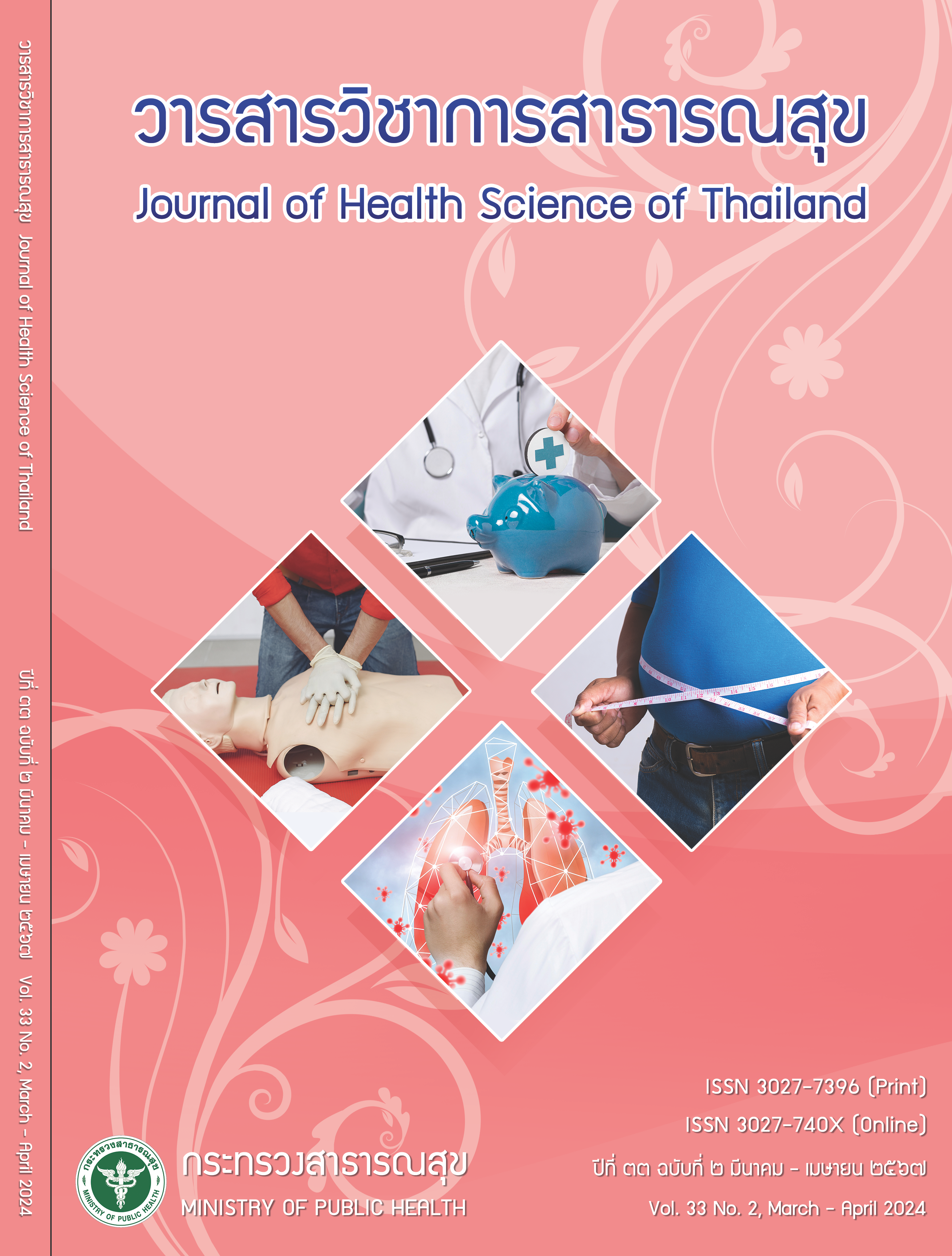Number of Occupational Therapy Sessions Influencing Improvement of Upper Extremity Functions in Stroke Patients
Keywords:
stroke, occupation therapy, upper extremity functionAbstract
Occupational therapy plays a crucial role in promoting upper limb mobility in stroke patients, with objectives to maximize self-assistance, reduce disability, and facilitate reintegration into society. However, studies on the quantity and frequency of rehabilitation remain limited, which impacts the establishment of service boundaries, guidelines, and resource allocation. This study aimed to investigate the frequency of rehabilitation sessions affecting upper limb mobility in stroke patients. Sixty-three stroke patients undergoing rehabilitation at the Sirindhorn National Medical Rehabilitation Institute received therapy three times a week, with each session lasting 60 minutes, totaling 45 sessions. Patients were assessed using the Fugl-Meyer Assessment (FMA) initially and every third session throughout the rehabilitation program. Descriptive statistics and paired t-tests (p<0.05) were conducted for data analysis. It was found that patients with mild upper limb impairment showed continuous improvement in FMA scores up to the 27th session, while those with moderate to severe impairment demonstrated improvement up to the 39th session. In conclusion, the number of rehabilitation sessions influencing upper limb mobility in stroke patients within one year of onset was found to be at least 27 sessions for mild impairment and 39 sessions for moderate to severe impairment.
Downloads
References
World Stroke Organization. Facts and figures about stroke [Internet]. 2022 [cited 2024 Jan 20]. Available from: https://www.world-stroke.org/world-stroke-day-campaign/why-stroke-matters/ learn-about-stroke
สมศักดิ์ เทียมเก่า. อุบัติการณ์โรคหลอดเลือดสมอง ประเทศไทย. วารสารประสาทวิทยาแห่งประเทศไทย 2566; 39(2):39-46.
ดานิล วงศ์ษา, ประทุม สร้อยวงค์, จินดารัตน์ ชัยอาจ. คุณภาพชีวิตของผู้ที่เป็นโรคหลอดเลือดสมองภายใน 6 เดือนแรกหลังได้รับการวินิจฉัย. พยาบาลสาร 2561; 45(2):40-50.
Govender P, Kalra L. Benefits of occupational therapy in stroke rehabilitation. Expert review of neurotherapeutics 2007;7(8):1013-9.
Rowland TJ, Cooke DM, Gustafsson LA. Role of occupational therapy after stroke. Ann Indian Acad Neurol 2008;11(Supplement 1):99-107.
American Occupational Therapy Association. Occupational therapy scope of practice. American Journal of Occupational Therapy 2021;75(Suppl 3):1-9.
พิศักดิ์ ชินชัย, ทศพล บรรยมาก. กิจกรรมบำบัดสำหรับผู้ที่ มีปัญหาด้านระบบประสาท. พิมพ์ครั้งที 4. เชียงใหม่: สยามพิมพ์นานา; 2560.
Hatem SM, Saussez G, della Faille M, Prist V, Zhang X, Dispa D, et al. Rehabilitation of motor function after stroke: a multiple systematic review focused on techniques to stimulate upper extremity recovery. Front Hum Neurosci 2016;10:442.
Jolliffe L, Lannin NA, Cadilhac DA, Hoffmann T. Systematic review of clinical practice guidelines to identify recommendations for rehabilitation after stroke and other acquired brain injuries. BMJ Open 2018; 8(2):1- 14.
Murrell JE, Pisegna JL, Juckett LA. Implementation strategies and outcomes for occupational therapy in adult stroke rehabilitation: a scoping review. Implement Sci 2021;16(1):105.
Theben J, Fearn J, Willems D, Sooley D, White J. Stroke rehabilitation intensity literature review. Ontario Stroke Network (OSN) Rehabilitation Intensity Working Group [Internet]. 2016 [cited 2024 Jan 20]. Available from: https://www.corhealthontario.ca/OSN-Stroke-Rehab-Intensity-Literature-Review-2016.pdf
Winstein CJ, Stein J, Arena R, Bates B, Cherney LR, Cramer SC, et al. Guidelines for adult stroke rehabilitation and recovery: a guideline for healthcare professionals from the American Heart Association/American Stroke Association. Stroke 2016;47(6):98-169
Wolf TJ, Nilsen DM. Occupational therapy practice guidelines for adults with stroke. Bethesda, MD: AOTA Press; 2015.
Boop C, Cahill SM, Davis C, Dorsey J, Gibbs V, Herr B, et al. Occupational therapy practice framework: domain and process fourth edition. American Journal of Occupational Therapy 2020;74(Suppl 2):1-87.
American Occupational Therapy Association. Standards of practice for occupational therapy. American Journal of Occupational Therapy 2022;75(Suppl 3):1-7.
Duncan P, Studenski S, Richards L, Gollub S, Lai SM, Reker D, et al. Randomized clinical trial of therapeutic exercise in subacute stroke. Stroke 2003;34(9):2173- 80.
คณินณ์ เศรษฐไพศาล, ปิยะภัทร เดชพระธรรม. ผลการฝึกโดยใช้หุ่นยนต์และกิจกรรมบำบัดกับกิจกรรมบำบัดเพียง อย่างเดียวต่อการฟื้นตัวของแขนและมือในผู้ป่วยโรคหลอดเลือดสมองระยะกึ่งเฉียบพลัน: การศึกษาแบบสุ่ม. เวชศาสตร์ฟื้นฟูสาร 2560;27(3):88-95.
Woodbury ML, Velozo CA, Richards LG, Duncan PW. Rasch analysis staging methodology to classify upper extremity movement impairment after stroke. Archives of Physical Medicine and Rehabilitation 2013; 94(8): 1527-33.
Almhdawi KA, Mathiowetz VG, White M, Delmas RC. Efficacy of occupational therapy task-oriented approach in upper extremity post-stroke rehabilitation. Occupational Therapy International 2016;23(4):444-56.
นวรัชต์ อุตรารัขต์กิจ, นัดดา รีชีวะ, พรรณเพชร ศิริรัตน์, พิธากร ธำรงเลาหะพันธุ์, วารี จิรอดิศัย. ผลการฟื้นฟูสมรรถภาพของการใช้งานรยางค์บนและล่างในผู้ป่วยโรคหลอดเลือดสมองระยะกึ่งเฉียบพลันและระยะเรื้อรัง ณ โรงพยาบาลรามาธิบดี: ภาควิชาเวชศาสตร์ฟื้นฟูคณะแพทยศาสตร์ โรงพยาบาลรามาธิบดี. เวชศาสตร์ฟื้ นฟูสาร 2559;26(2):47-53.
Doğan AG. The effect of occupational therapy on upper extremity function and activities of daily living in hemiplegic patients. Journal of Medicine and Palliative Care 2023;4(4):350-4.
Coupar F, Pollock A, Rowe P, Weir C, Langhorne P. Predictors of upper limb recovery after stroke: a systematic review and meta-analysis. Clinical Rehabilitation 2012;26(4):291-313.
Wu J, Zhang J, Bai Z, Chen S, Cai S. Predictive factors of upper limb motor recovery for stroke survivors admitted to a rehabilitation program. European Journal of Physical and Rehabilitation Medicine 2020;56(6):706- 12.
Bailes AF, Reder R, Burch C. Development of guidelines for determining frequency of therapy services in a pediatric medical setting. Pediatric Physical Therapy 2008; 20(2):194-8.
Downloads
Published
How to Cite
Issue
Section
License
Copyright (c) 2024 Ministry of Public Health

This work is licensed under a Creative Commons Attribution-NonCommercial-NoDerivatives 4.0 International License.







